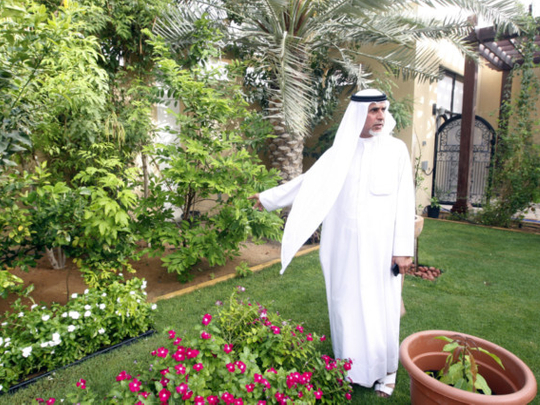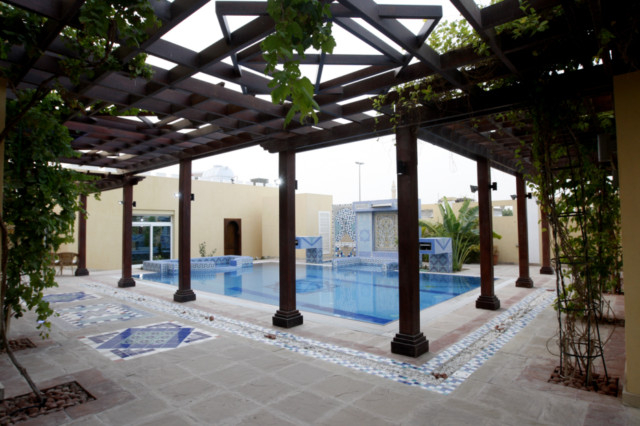
Dubai: Imagine smiling at the Dewa bill? You would, if you had a home like the one Abdullah Saif Bin Mes’Har Al Muhairi has built.
Covering a built up area of 8,500 sqft, the sprawling Moorish-styled villa in Al Barsha 3 with jasmine arbors incorporates best practices that reduce energy consumption and conserve water. Designed with the idea of sustainable living, the home is an expression of Al Muhairi’s belief that it is possible to create something of lasting beauty and not be a burden on the environment.
A civil engineer by profession, he was with Etisalat and retired from the company from the Administration and Human Resource Department. Post retirement, he set up plans to build a house. And, as is the norm obtained quotations.
He said: “It was a conventional house design. This was in 2008. I received a quotation of Dh4.5 million.”
It was a big sum and a lot of investment; also it did not feature the use of any sustainable material. Unhappy with the outcome, Al Muhairi set out on a journey of discovery.
He decided to build his own house – design it, source the materials and procure the necessary labour, without any firms, agencies or consultants.
Foundation
The UN World Environment Day being celebrated today has two words in its theme that Al Muhairi has stringently applied in the building process of the villa – think, save.
“My first objective when I re-designed the villa was to reduce the amount of concrete and quantity of steel being used. Usually the roof is heavy, so the columns and beams holding them up have to be big (to withstand the weight).” This has an impact on the foundation, all of which means vast quantities of concrete and steel usage. It results in a direct increase in the carbon footprint of a building.
“Instead of hollow blocks (concrete) for the roof, I used a light insulated material. I used 20 centimetres of extruded polystyrene. It can be lifted by a child,” he said. To break it down further, this is a kind of material that insulates but is extremely strong. So, as it is way lighter, it reduces the weight on the columns and conserves energy, because of the insulation, the rooms don’t heat up. “Also, white reflects the light… the roof has a (final) layer of white cement tiles … heat will not enter.”
The walls are made of aerated blocks that have trapped air within them that, again, acts as insulation. He has also layered the foundation with extruded polystyrene.
Energy saving from air conditioning – a conservative estimate of “35 per cent” he said, as the usual temperature setting for the rooms are 24C.
That was not enough. Al Muhairi sourced LED (Light Emitting Diode) lights from China, because LED lamps function for years and have high energy efficiency compared to other lights.
He estimated nearly 90 per cent saving in energy consumption with the use of LED lights and by reducing the number of electrical points.
Home automation
Al Muhairi has a specialised home automation system that ensures with the help of a master control no light gets left on in the house, also with motion sensor activated lights installed in passage ways and bathrooms, there is no waste.
On the issue of energy use, Al Muhairi said: “One of the biggest sources of electricity consumption is water heaters… we have 365 days of sun here. It is important to use that. The government needs to reduce the money they are investing in electricity, so should encourage solar energy use.” He set up solar water heaters for the entire villa and its guest house facilities.
“We see wastage of water when you open a tap (for hot water). You wait for 10 seconds for the water to run hot. I used circulation pumps to prevent this waste.” Additionally, he installed special water closets that use 1.2 litres less than the conventional WC in every flush.
For the pool covered in recycled tiles, too, he set up energy saving pumps with variable speed to re-circulate the water, depending on if it is in use or being cleaned.
Al Muhairi wanted to do more. He personally did the landscaping and designed the irrigation system. Wood shavings from the building of doors and cupboards from within were mixed into the soil to help retain moisture.
It today boasts several fruit trees including mango, guava, tangerine, pomegranate, custard apple, olive and lemon, along with strawberries, raspberries, blackberries, pineapples, bananas, vegetables and herbs.
The exercise was not cheap but it was a labour of love and Al Muhairi is proud of what he has built.
“For the price of the original quotation I could add a guest house, pool and additional facilities. Also, in the long term the saving is immense, in terms of energy and water. It is a green villa.















